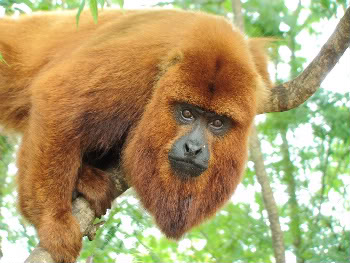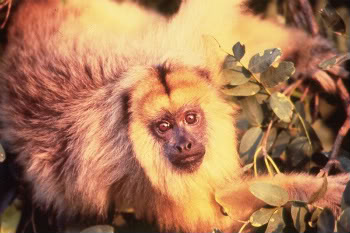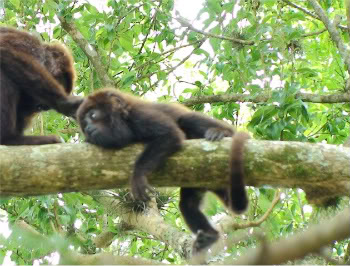|
|
There have been numerous reports of howler monkeys poisoned in the southernmost Brazilian state of Rio Grande do Sul due to misinformation regarding the monkeys and the yellow fever virus. Some locals believed that the monkeys, which also suffer from yellow fever, were in fact the disease-carriers, but yellow fever is carried by mosquitoes not monkeys.
A new campaign headed by Dr. Julio Cesar Bicca-Marques wants to set the record straight. The campaign, entitled ‘Save Our Guardian Angels’, is working to inform the public of the actual and important role of howler monkeys in yellow fever outbreaks.
 Adult male brown howler monkey. Photo Julio Cesar Bicca Marques. |
“Howler monkeys are more susceptible to the [yellow fever] virus and often die a few days after being bitten by an infected mosquito. The death of howlers alerts local health offices to the local spread of the virus in the region enabling the implementation of local vaccination campaigns. Far from being seen as a threat,” Bicca-Marques explains, “the Brazilian Ministry for Health considers these monkeys important ‘sentinels’ for the circulation of the virus. So howler monkeys are in fact our ‘Guardian Angels’! Their disappearance would mean our discovery of the arrival of yellow fever in a given region would only occur once the disease had been contracted by people, and for many by that time it may well be too late!”
Since the end of 2008, seven people have died from yellow fever in Rio Grande do Sul, while nine more have succumbed to the disease in the state of Sao Paulo. It was this sudden outbreak of the disease that led some unknown locals to poison the howler monkeys. Bicca-Marques, a primatologist at Pontifícia Universidade Católica do Rio Grande do Sul, says that the media is partly to blame for the misinformation that leading to the howler monkeys’ death.
 Female black-and-gold howler monkey. Photo by: Julio Cesar Bicca Marques. |
“[The media] has frequently related the disease with the observation of sick, but especially, dead howler monkeys, without taking the appropriate steps to stress that mosquitoes are the vectors of the yellow fever,” Bicca-Marques told Mongabay.com. “In the absence of this essential information on the mode of transmission, people have wrongly interpreted that the monkeys are the responsible for the current yellow fever outbreak.”
Howler monkeys in Brazil are not just suffering from human ignorance. Other threats have caused the two species of howler monkey in the state to be listed as Vulnerable on the Red List in Rio Grande do Sul.
“In addition to the current high mortality by yellow fever and the killing of monkeys as a consequence of this misinformation, both black-and-gold Alouatta caraya and brown Alouatta guariba clamitans howler monkeys are threatened by habitat loss, and the illegal hunting and pet trade,” Bicca-Marques says. “As a consequence they live mostly in small populations in highly fragmented and isolated forest patches within an agricultural and cattle ranching landscape.”
 Infant brown howler monkey with parent. Photo Julio Cesar Bicca Marques. |
Deforestation may not only be negatively affecting the howler monkeys; it may also play a role in the sudden rise in yellow fever. “State health authorities observed a population explosion of mosquitoes in the last spring and summer, likely related to climate changes and habitat alteration,” says Bicca-Marques.
Bicca-Marques hopes that his campaign will effectively educate local Brazilians about the innocence of howler monkeys when it comes to yellow fever. In fact, the monkeys are actually more susceptible to the disease than people, often succumbing within a few days of being bitten by a mosquito carrying the virus.
“It is crucial to inform the population that there is no possibility that the spread of the disease within the State of Rio Grande do Sul, or the State of São Paulo where an outbreak began this year, has any relationship with the howler monkeys,” Bicca-Marques says. “The campaign Protect our Guardian Angels has this goal.”
Related articles
48% of primates threatened with extinction
(08/05/2008) 48 percent of the world’s primate species are at risk of extinction, according to the first comprehensive review of the world’s primates since 2003. The results were released as an update to the IUCN Red List at the 22nd International Primatological Society Congress in Edinburgh, Scotland.
Fragmentation puts Mexican howlers at risk
(03/03/2008) Forest fragmentation is putting mantled howler monkeys in southern Mexico at risk, reports a new study, published in the inaugural issue of the open access e-journal Tropical conservation Science.
(03/24/2007) A study carried out in the Caatinga forest of Serra da Capivara National Park in the Piaui state of northeast Brazil provides new evidence for the existence of culture in monkeys. The research, published by Dr Antonio Moura, a Brazilian researcher from the Department of Biological Anthropology at the University of Cambridge, suggests that monkeys can learn skills from each other, in the same manner as humans. Moura found signs that Capuchin monkeys in Brazil teach each other to bang stones as a signaling device to scare off potential predators.